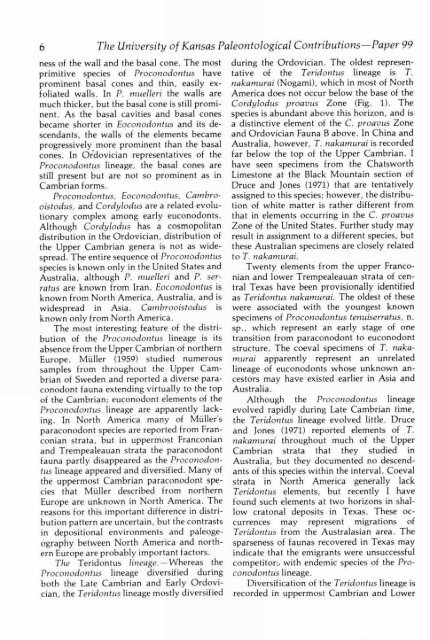View - KU ScholarWorks - University of Kansas
View - KU ScholarWorks - University of Kansas
View - KU ScholarWorks - University of Kansas
Create successful ePaper yourself
Turn your PDF publications into a flip-book with our unique Google optimized e-Paper software.
6 The <strong>University</strong> <strong>of</strong> <strong>Kansas</strong> Paleontological Contributions—Paper 99<br />
ness <strong>of</strong> the wall and the basal cone. The most<br />
primitive species <strong>of</strong> Proconodontus have<br />
prominent basal cones and thin, easily exfoliated<br />
walls. In P. muelleri the walls are<br />
much thicker, but the basal cone is still prominent.<br />
As the basal cavities and basal cones<br />
became shorter in Eoconodontus and its descendants,<br />
the walls <strong>of</strong> the elements became<br />
progressively more prominent than the basal<br />
cones. In Ordovician representatives <strong>of</strong> the<br />
Proconodontus lineage, the basal cones are<br />
still present but are not so prominent as in<br />
Cambrian forms.<br />
Proconodon tus, Eoconodon tus, Cambrooistodus,<br />
and Cordylodus are a related evolutionary<br />
complex among early euconodonts.<br />
Although Cordylodus has a cosmopolitan<br />
distribution in the Ordovician, distribution <strong>of</strong><br />
the Upper Cambrian genera is not as widespread.<br />
The entire sequence <strong>of</strong> Proconodontus<br />
species is known only in the United States and<br />
Australia, although P. muelleri and P. serratus<br />
are known from Iran. Eoconodontus is<br />
known from North America, Australia, and is<br />
widespread in Asia. Carnbrooistodus is<br />
known only from North America.<br />
The most interesting feature <strong>of</strong> the distribution<br />
<strong>of</strong> the Proconodontus lineage is its<br />
absence from the Upper Cambrian <strong>of</strong> northern<br />
Europe. Muller (1959) studied numerous<br />
samples from throughout the Upper Cambrian<br />
<strong>of</strong> Sweden and reported a diverse paraconodont<br />
fauna extending virtually to the top<br />
<strong>of</strong> the Cambrian; euconodont elements <strong>of</strong> the<br />
Proconodontus lineage are apparently lacking.<br />
In North America many <strong>of</strong> MilIlers<br />
paraconodont species are reported from Franconian<br />
strata, but in uppermost Franconian<br />
and Trempealeauan strata the paraconodont<br />
fauna partly disappeared as the Proconodontus<br />
lineage appeared and diversified. Many <strong>of</strong><br />
the uppermost Cambrian paraconodont species<br />
that MüIler described from northern<br />
Europe are unknown in North America. The<br />
reasons for this important difference in distribution<br />
pattern are uncertain, but the contrasts<br />
in depositional environments and paleogeography<br />
between North America and northern<br />
Europe are probably important factors.<br />
The Teridontus lineage. —Whereas the<br />
Proconodon tus lineage diversified during<br />
both the Late Cambrian and Early Ordovician,<br />
the Teridontus lineage mostly diversified<br />
during the Ordovician. The oldest representative<br />
<strong>of</strong> the Teridontus lineage is T.<br />
nakamurai (Nogami), which in most <strong>of</strong> North<br />
America does not occur below the base <strong>of</strong> the<br />
Cordylodus proavus Zone (Fig. 1). The<br />
species is abundant above this horizon, and is<br />
a distinctive element <strong>of</strong> the C. proavus Zone<br />
and Ordovician Fauna B above. In China and<br />
Australia, however, T. nakamurai is recorded<br />
far below the top <strong>of</strong> the Upper Cambrian. I<br />
have seen specimens from the Chatsworth<br />
Limestone at the Black Mountain section <strong>of</strong><br />
Druce and Jones (1971) that are tentatively<br />
assigned to this species; however, the distribution<br />
<strong>of</strong> white matter is rather different from<br />
that in elements occurring in the C. proavus<br />
Zone <strong>of</strong> the United States. Further study may<br />
result in assignment to a different species, but<br />
these Australian specimens are closely related<br />
to T. nakamurai.<br />
Twenty elements from the upper Franconian<br />
and lower Trempealeauan strata <strong>of</strong> central<br />
Texas have been provisionally identified<br />
as Teridontus nakamurai. The oldest <strong>of</strong> these<br />
were associated with the youngest known<br />
specimens <strong>of</strong> Proconodontus tenuiserratus, n.<br />
sp., which represent an early stage <strong>of</strong> one<br />
transition from paraconodont to euconodont<br />
structure. The coeval specimens <strong>of</strong> T. nakamurai<br />
apparently represent an unrelated<br />
lineage <strong>of</strong> euconodonts whose unknown ancestors<br />
may have existed earlier in Asia and<br />
Australia.<br />
Although the Proconodontus lineage<br />
evolved rapidly during Late Cambrian time,<br />
the Teridontus lineage evolved little. Druce<br />
and Jones (1971) reported elements <strong>of</strong> T.<br />
nakamurai throughout much <strong>of</strong> the Upper<br />
Cambrian strata that they studied in<br />
Australia, but they documented no descendants<br />
<strong>of</strong> this species within the interval. Coeval<br />
strata in North America generally lack<br />
Teridontus elements, but recently I have<br />
found such elements at two horizons in shallow<br />
cratonal deposits in Texas. These occurrences<br />
may represent migrations <strong>of</strong><br />
Teridontus from the Australasian area. The<br />
sparseness <strong>of</strong> faunas recovered in Texas may<br />
indicate that the emigrants were unsuccessful<br />
competitor, with endemic species <strong>of</strong> the Proconodontus<br />
lineage.<br />
Diversification <strong>of</strong> the Teridontus lineage is<br />
recorded in uppermost Cambrian and Lower
















